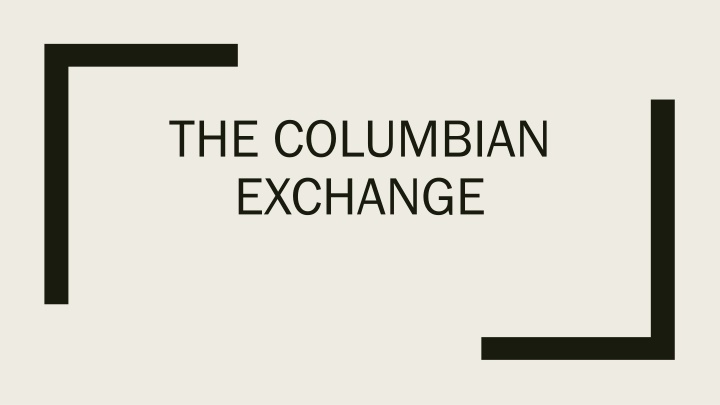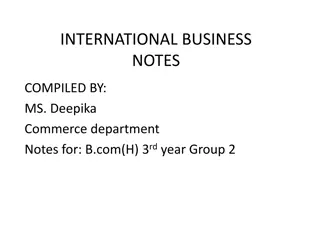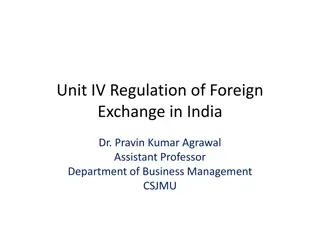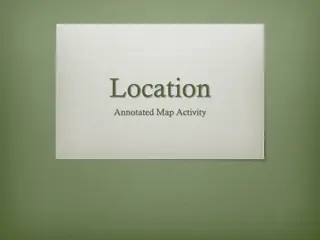The Columbian Exchange - Transfer of Goods, Ideas, and Diseases between Hemispheres
The Columbian Exchange was a significant transfer of animals, plants, culture, technology, and diseases between the American and Afro-Eurasian hemispheres in the 15th and 16th centuries. This exchange shaped the course of history, impacting populations on both continents through the introduction of new agricultural products, animals, and devastating diseases like smallpox among Native Americans. Alfred W. Crosby's work in 1972 highlighted the importance of this exchange in global history.
Download Presentation

Please find below an Image/Link to download the presentation.
The content on the website is provided AS IS for your information and personal use only. It may not be sold, licensed, or shared on other websites without obtaining consent from the author.If you encounter any issues during the download, it is possible that the publisher has removed the file from their server.
You are allowed to download the files provided on this website for personal or commercial use, subject to the condition that they are used lawfully. All files are the property of their respective owners.
The content on the website is provided AS IS for your information and personal use only. It may not be sold, licensed, or shared on other websites without obtaining consent from the author.
E N D
Presentation Transcript
THE COLUMBIAN EXCHANGE
What is the Columbian Exchange? The Columbian Exchange was the widespread transfer of animals, plants, culture, human populations, technology, and ideas between the American and Afro-Eurasian hemispheres in the 15th and 16th centuries. Basically the exchange between the New and Old Worlds.
Similar to The Renaissance in that it did not get its name until centuries later. In 1972 Alfred W. Crosby, an American historian at the University of Texas at Austin, published The Columbian Exchange.
Named after this guy. Sailed for the Spanish, but was actually Italian. Was sailing to find a quicker route to Asia. Accidently hit the Americas, because no one knew it was really there. Made a ton of $$$ Wasn t the actual first person to discover the Americas. Wasn t a great guy, we ll read about that today. Is celebrated today with a holiday which has become increasingly debated.
From the Americas to Afro-Eurasia Beans (kidney, navy, lima) Black-eyed Susans Vanilla beans Tomatoes Tobacco Avocados Bell peppers Cacao (for chocolate) Sweet potatoes Sunflowers Squashes Chili peppers Corn Cotton Rubber Turkeys Marigolds Papayas Peanuts Petunias Quinine Zinnias Pineapples Poinsettias Potatoes Pumpkins
From Afro-Eurasia to the Americas Sugarcane Wheat Horses Bananas Barley Cabbages Sheep Pigs Lettuce Lemons Chickens Coffee Cows Rice Peaches Crabgrass Daffodils Daisies Dandelions Oranges Tulips Disease Turnips Lilacs Olives Pears Carnations
Diseases in the Americas While Europeans and Asians were affected by the Eurasian diseases, their presence in those continents over centuries resulted in many people gaining acquired immunity. By contrast, "Old World" diseases had a devastating effect when introduced to Native Americans because they had no natural immunity to the diseases. Measles, influenza, typhus, smallpox, malaria, whooping cough, and a few others.
The smallpox epidemics are believed to have caused the largest death tolls among Native Americans, surpassing any wars and far exceeding the comparative loss of life in Europe due to the Black Death. It is estimated that upwards of 80 95 percent of the Native American population died in these epidemics within the first 100 150 years following 1492. Many regions in the Americas lost 100% of their population. This is the largest genocide in human history. 70+ million in the Americas, down to 3.5 in a 100 years.
Impact on today Before 1500 AD, potatoes were not grown outside of South America. By the 1840s, Ireland was so dependent on the potato that the cause of the Great Famine was a potato disease. Maize and manioc, introduced by the Portuguese from South America in the 16th century, have replaced sorghum and millet as Africa's most important food crops.
Tomatoes, which came to Europe from the New World via Spain, were initially prized in Italy mainly for their ornamental value. From the 19th century tomato sauces became typical of Neapolitan cooking and, ultimately, Italian food in general. Coffee (introduced in the Americas circa 1720) from Africa and the Middle East and sugar cane (introduced from South Asia) from the Spanish West Indies became the main export commodity crops of extensive Latin American plantations. Introduced to India by the Portuguese, chili and potatoes from South America have become an integral part of Indian cuisine. Before the Columbian Exchange, there were no oranges in Florida, no bananas in Ecuador, no paprika in Hungary, no potatoes in Ireland, no coffee in Colombia, no pineapples in Hawaii, no rubber trees in Africa, no chili peppers in Thailand, no tomatoes in Italy, and no chocolate in Switzerland.























